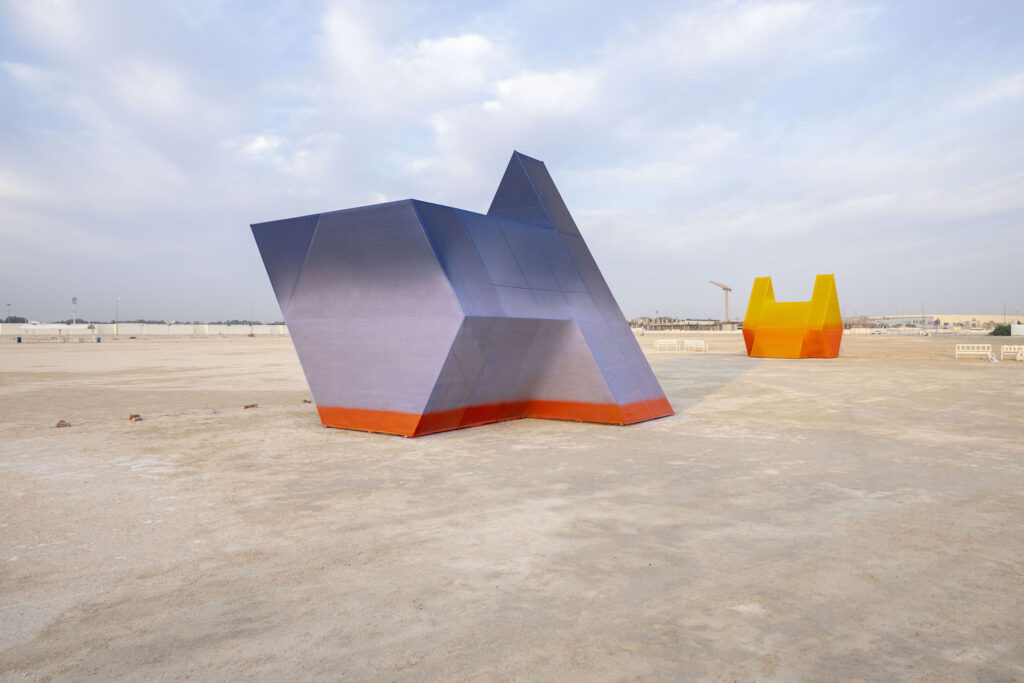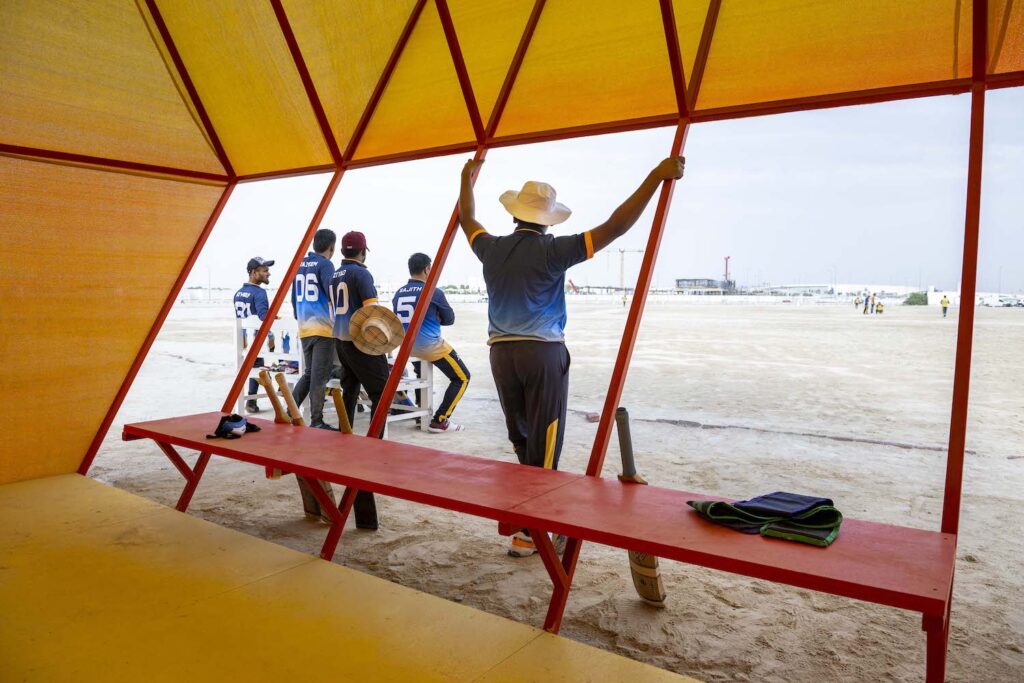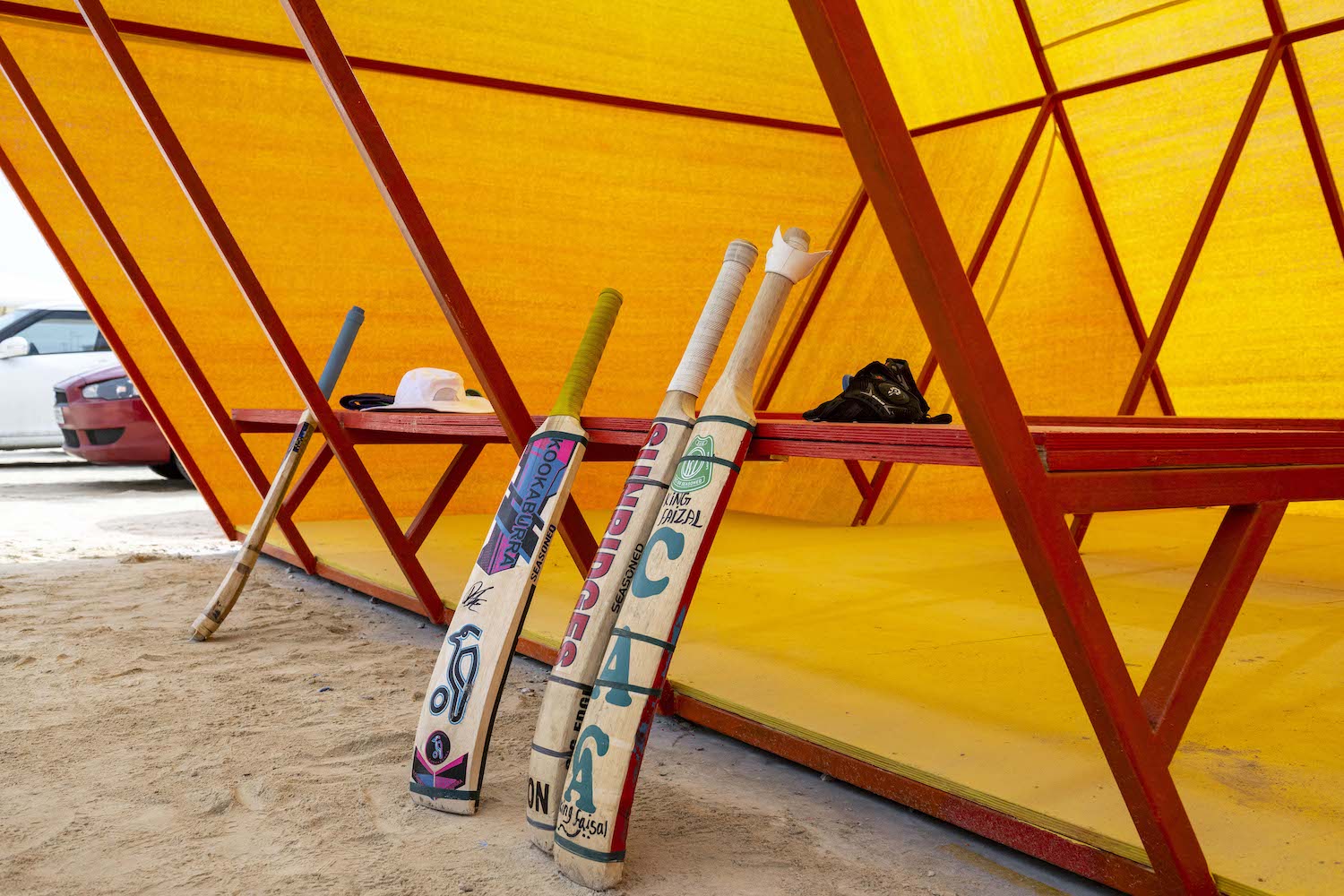Seoul-based design firm MOTOElastico collaborated with artist Michael Perrone on a project with a distinct emphasis on catering to the Doha cricket community's well-being. This endeavor, named "Shelters," centers on the creation of temporary landmarks that serve a dual purpose: offering respite from the scorching Qatari sun and creating a resting haven for cricket enthusiasts.
In this user-centered design (UCD) approach, meticulous attention is given to addressing the specific requirements of the cricket players. Given the remarkable popularity of cricket, especially among Doha's South Asian residents, the design team has crafted temporary, tent-like structures featuring angular forms and vibrant color combinations. The intention is for these structures to serve as places of rest, all while adhering to the principles of UCD. These shelters are carefully constructed using steel frames, covered with Gale Shadecloth fabric, and adorned with vivid paint, ensuring they are both functional and visually appealing.
In Doha, cricket matches often unfold on improvised pitches within vacant dirt lots or empty parking areas, forming a cherished social tradition that unites individuals from diverse backgrounds through their shared passion. However, there is a noticeable absence of infrastructure to support these informal games. The "Shelters" project not only honors the cricket community but also exemplifies the core principles of user-centered design. It provides two unique structures that can serve as meeting spaces and areas for relaxation, all designed with the needs, preferences, and behaviors of the end users in mind.
We spoke with Marco Bruno, co-founder of MOTOElastico, to understand more about their design approach and its impact on the people they serve.

Marsya Abdulghani: How does MOTOElastico incorporate user-centered design principles into your projects?
Marco Bruno: We think that a good and well thought project should always manage to satisfy user needs. What interests us the most is discovering and revealing areas where design can make a difference not only practically but also symbolically. The Shelters project is a good example.
Cricket is a very popular sport in Doha and it is the second most practiced sport in the world, after football. However, outside of the cricket community, in a multicultural society, its relevance seems to fade away. When we started to explore the Doha cricket scene, we realized how socially meaningful Friday morning games are. We decided that the main goal of the project should be revealing this phenomenon and celebrating these communities, rather than simply designing efficient protections from wind and sun, which you can already find in some public pitches in Doha. The users are at the center in our project because we try to elevate their role in society, and not just to protect them with a comfortable space. Our Shelters are not a definitive solution, but the beginning of a process that hopefully will help to shift the perception of cricket in Qatar.

(M.A): What techniques or methodologies do you use to understand and address the needs of the end users in your designs?
(M.B): The Shelters project is again a good example to understand how we operate in cases like this one. We are naturally interested in exploring and understanding the dynamics behind the use of public space, especially when people develop creative strategies that push the boundaries of what is normally considered acceptable. We always start our projects with direct observations of the context in which we decide to operate. The people that play street cricket in Doha tend to always use the same place for their Fridays’ game. They normally build a concrete pitch in the center of the field, they mark the boundary using stones or concrete bricks and they keep the whole area clean and tidy. Practically they are missing a space with shade where they can rest comfortably, but from a psychological point of view, they need social acceptance and recognition. With our project we tried to address both needs, without setting any priority.

(M.A): Are there any recent design innovations or trends that have particularly influenced your work?
(M.B): We are particularly interested in two opposite contemporary design trends. On one side the proliferation of AI generated images that are suddenly substituting all the visual references that humanity has crafted in centuries of visual explorations: we are certainly entering an unknown territory and it is exciting to think where this voyage can take us. On the other side we are fascinated by people that decide not to use any digital tool, such as CAD models or drawings, to design objects and spaces, and utilize only traditional techniques in order to achieve uniqueness and keep the human aspect at the center of the creative process. Definitely in this project, working with a great painter like Michael Perrone, who feels the colors before seeing them, we explored the analog side, but we are looking forward to diving into the digital side in our next project.
(M.A): How do you measure the impact of your designs on the communities or users you serve?
(M.B): Whenever you start to work with a public project that affects different groups of people, you always face different kinds of reactions spanning from unconditional support, to tepid indifference, all the way to fierce criticism. It is very important to control the extremes, but most of all it is crucial to find a way to involve as many people as possible in the process, especially those who initially were not engaged at all. If you manage to do so, your project will be successful and the community that you worked with will take care of the space and will develop a sentimental attachment with it that will go beyond its pragmatic functionality. We don’t know how to measure that, but some people simply call it love.
Shelters project data:
Project by: MOTOElastico & Michael Perrone
Design Team: Marco Bruno, Michael Perrone, Simone Carena
Year: 2022/23
Commissioner: Qatar Museum, Public Art Department
Host: Qatar Cricket Association
Construction: Abdullah Ibrahim Jaidah and son’s
Location: Lusail Cricket Ground, Lusail, Doha, Qatar
Materials: Steel frame, Gale Shadecloth fabric, paint
Photos: Raviv Cohen
www.motoelastico.com







